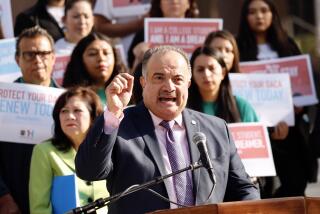College’s Success Is Bad News, Neighbors Complain
A decade ago, struggling Marymount Palos Verdes College--its enrollment down to 116 and its deficit up to $170,000--limped onto the campus of a former girls’ school on a 22-acre promontory overlooking the Pacific.
“Most people thought we would fail,” said Dr. Thomas D. Wood, president of the two-year Roman Catholic liberal arts college in Rancho Palos Verdes.
Failure, however, was not in the college’s future. It began to prosper after a few more lean years, and by the late 1970s enrollment had climbed to nearly 300 students. It has nearly doubled since then and the deficit has long since vanished.
Night classes were started, and two years ago the college began a program for working adults that meets two weekends a month. The program has 162 students.
“We are recognized as a unique educational resource,” said Wood.
But an organized group of residents near the college have another word to describe it. They call it a nuisance that produces noise, litter and a gaggle of automobiles driven by students who use their streets for parking, sometimes blocking driveways and access to fire hydrants.
“We moved into a residential area promising quiet,” said spokeswoman Mary Knight. “But every day the environment is changing for the worse.”
Sharon Hightower, city director of environmental services, described the situation as a classic clash between homes and other land uses. “Residential areas always are in conflict with anything different,” she said.
The residents recently filed a petition with the city asking that the college be declared a nuisance for alleged violations of a conditional use permit the city issued to the college in 1975. That permit allowed Marymount to move to the former girls’ school on Palos Verdes Drive East from another site in the city that had been sold to the Salvation Army.
Residents along San Ramon Drive, where some homes back up against college grounds and where the parking problem is said to be the most severe, have asked for a parking zone that would restrict the street to residents and their guests between 9 a.m. and 5 p.m. Knight, who lives on San Ramon, said she has counted 25 to 30 cars on the street during school hours. She said residents do not want permit parking but have been “forced to ask for it.”
Although the controversy has been simmering for a long time, officials say this is the first time it has reached the City Council, which is scheduled to take it up on Tuesday. The discussion is expected to range from the parking situation and compliance with permit conditions to control of the college’s growth and scope.
Wood said an 87-car parking lot he wants completed by July 1 should relieve much of the parking problem, although he concedes that some cars still will spill into the streets.
Knight said the neighborhood needs permit parking now to deal with its immediate problem. Even if there is more campus parking, she said, students still will gravitate toward San Ramon if space is available.
At a meeting last week with city officials, Wood agreed to correct certain permit violations--the most serious of them involving student use of a road adjacent to some homes. Traffic will be reduced by rerouting internal parking access, he said. The college also will support permit parking for the residents and will wage a “strong campaign” to educate students about being good neighbors.
The college president said he already had decided to put a 650-student cap on enrollment. “The college has reached the size it should be,” he said.
“There are no bad guys in this,” said Councilman Robert Ryan. “This thing just got going and I’m confident that when we sit down, we can address the concerns.”
He said Marymount has recognized that it must become “more pro-active” in solving the problems.
Saying that most people in the area regard Marymount as a good neighbor, Wood described the college critics as “a few militants who will continue to complain no matter what we do. They’d prefer that we go away.”
He disputed assertions that “hundreds” of cars from the college park on San Ramon and other streets. He said 75 to 100 is a better estimate, adding that the college has used everything from “pleading to threats” to persuade students not to park on the streets.
Marymount estimates that up to 300 employee and student cars come to the campus daily. It now has 168 on-campus parking spaces.
A key issue in the dispute is whether Wood made commitments about the eventual size of the college during a 1975 hearing before the city Planning Advisory Committee, which granted Marymount the permit to operate.
At that time, residents raised questions about such things as projected enrollment, hours of operation, the nature of weekend activities. They suggested a restriction on enrollment to prevent a “change in density.”
Wood responded by saying that enrollment would be between 250 and 275 students, parking would be contained to the campus, there might be some evening seminars but weekend activities would be minimal.
Those responses, however, were not made conditions of the permit, which relates largely to matters of landscaping, buffering and control of the access road. City officials concede that the omissions have led to the present controversy.
“They should have been put in, but that’s hindsight,” said environmental director Hightower.
Residents assert that Wood’s statements were commitments and that he broke faith with them, and with the city, by allowing Marymount to grow to its present size.
Wood, however, said he was making projections based on the condition of the college 10 years ago “when we were preoccupied with survival. I was not making a commitment and I was asked to speculate, and I did.”
Wood said he thought he was being optimistic about Marymount at the time, but when the college’s fortunes took a turn for the better, he felt under no obligation to limit growth.
Hightower said the “bottom line” is the permit. “Anything not put into the (conditional use permit) is not legally binding,” she said.
Mayor John McTaggart, a member of the planning committee when the permit was issued, said he was swayed by Woods’ presentation and did not see a need for imposing growth limits as conditions. “We were a new city, we were all greenhorns and we had no expertise in dealing with conditions for a permit for a college,” he said.
Ryan, who has been a councilman since the city was incorporated in 1973, said no one thought there would be a problem. “We figured a small college was no different than a high school,” he said.
Both sides say that serious problems between the college and the neighborhood erupted three years ago and grew worse in 1984. A city chronology of complaints mentions parking, fences, noise, litter and glaring lights. Residents also complained about two volleyball courts--not yet installed--and as the result, the college was ordered to stop grading for the courts until it obtained a permit.
A month ago, Wood sent a letter to the entire San Ramon neighborhood apologizing for “discomfort caused by the excessive noise and rude behavior” of college and high school students at a St. Patrick’s Day dance. Sheriff’s deputies broke up the affair at the college’s request.
Barbara Covey, who has lived on San Ramon for 23 years, said everyone has a different problem with the college. “I’ll have the volleyball court behind my house and I’ll feel like I’m a part of the game,” she said. “My neighbor has the noise from the tennis courts and further up, there’s the parking problem.”
But Wood’s present problems with the neighbors are not the life-and-death issues he faced 10 years ago. The college’s fortunes began declining in 1968 when long-established Marymount University affiliated with Loyola University and moved to Westchester, becoming Loyola-Marymount. Marymount Palos Verdes became a two-year-college on the old campus.
“We were a stepchild,” Wood said.
That campus later was sold to the Salvation Army in order to pay debts and Wood said if the college had not been able to move to its present home, “it would not have survived.”
More to Read
Sign up for Essential California
The most important California stories and recommendations in your inbox every morning.
You may occasionally receive promotional content from the Los Angeles Times.









